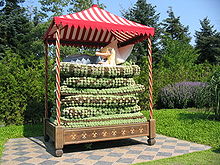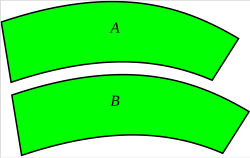Introduction to psychology/Psy102/Tutorials/Sensation and perception
Sensation and perception[nb 1]
| Resource type: this resource contains a tutorial or tutorial notes. |
| Completion status: this resource is considered to be complete. |
Learning objectives
[edit | edit source]Sensation
- Understand the processes of sensation
- Understand Weber’s principle
- Understand that our senses can interact – they are not completely independent.
Perception
- Understand the processes of perception - selecting, interpreting and organising the signals we receive from our senses into meaningful information.
- Understand the role of binocular cues in depth perception.
- Understand how "optical illusions" illustrate the use of difference processes for sensation and perception.
What you will need
[edit | edit source]This is a very hands-on tutorial and several of the activities require some equipment:
Weber's principle
|
Horizontal-vertical illusion
|
Depth perception
|
The Wundt-Jastrow Illusion
|
Optical illusion sets
|
Handouts
|
Introduction to sensation and perception (5 mins)
[edit | edit source]
Tutor's note: Students won't have had the sensation and perception lecture yet, so we need to put the activities "in context" at the start by explaining/orientating them to Sensation and Perception (check Gerrig et al., (2008) textbook):

- Sensation is experiencing signals via our senses and converting them into neural signals for the brain. What are the senses? Vision, Hearing, Touch, Taste, Smell. How "good" are each of these senses? (Answer: They work well - but they are imperfect - they specialised to pick up a limit range and their range and acuity is not as well developed as the senses are in some other species). Interestingly, all senses probably evolved over time as specialised forms of "touch".
- Perception is the process of attaining awareness or understanding of sensory information.
- Sensation and perception in a robot

One handy way of explaining sensation and perception is to imagine designing a human replicant robot from scratch. One of the fundamental challenges is to design a sensory input system in order to extract information about the surrounding environment. This might include:
- Vision
- Hearing
- Touch
- Smell
- Taste
(The first three are probably most important to a robot; the latter two relate more closely to human's need to extract nutritious food from the environment)
The second design challenge is arguably more significant; the robot will need a system which takes the incoming sensory information and "perceives" it, i.e., organises the information, extracts meaningful patterns, interprets, and ultimately then makes behavioural decisions/actions based on that information.
Human beings, through evolution, have emerged (as have other animals) with finely honed sensory and perceptual systems which can detect order and patterns even in low-information environments.
Weber’s law: Difference threshold (15 mins)
[edit | edit source]
- Get students to form into groups.
- Give each group two envelopes and ask them to put one 20c piece in one envelope and two 20c pieces in the other.
- Invite each member of the group to hold both envelopes, one in each hand. They should be able to easily distinguish which is the heavier envelope.
- Now ask for a volunteer in each group to take off their shoes (or use two textbooks if they don’t want to take off their shoes). Get the students to put one envelope in each shoe or each textbook. Now if they hold one shoe/textbook in each hand they will find that it is no longer easy to say which is heavier. Because the shoes weigh more, the difference between the shoes must be greater for us to notice the difference.
- Weber’s law: Difference thresholds grow with the magnitude of the stimulus, because the difference is a percentage of the magnitude of the stimulus, not a constant amount.
- Ask students for examples of Weber's principle in their everyday life
- See also: Weber-Fechner law, Weber's law
Interaction of sensory information: Vision and balance (10 mins)
[edit | edit source]These exercises demonstrate how our brain utilises visual and vestibular information in helping us to maintain balance.

- Everyday balance
- Ask students to stand up and to make sure that each person has a bit of space because they're going to be doing balancing
- Ask students how is it they remain standing, without falling over - and without even thinking consciously about it - what sensory and perceptual processes are occurring? Through facilitated discussion, guide students towards realising that it is probably via a combination of visual information (e.g., information about the horizon) and the inner ear's vestibular system (which works like a spirit level). In addition, students may identify touch with pressure for example on one side of the foot indicating leaning.
- Challenging the vestibular system: One-foot balances with eyes open and closed
- 1 foot, open eyes: Have students stand on one foot for 30 seconds with their eyes open
- 1 foot, closed eyes: ...and then with them shut. The latter is more difficult because the vestibular and visual systems work together to enable us to maintain balance. With their eyes closed, students are relying only on their vestibular system.
- 1 foot, closed eyes, dizzy: Ask students to spin around a few times (thus disrupting their vestibular sense), then close their eyes and balance on one leg - they will find it impossible as the vestibular system can no longer provide the information they need.
- Challenging the visual system: One-foot balances, one eye, visual distortion
- Have students stand on one foot.
- Have them open the eye on the same side as the foot they are standing on and look at some convenient point or object. The other eye should be closed.
- Very carefully and gently press with their index finger on the same side of their open eye against the eyelid of that eye. As they gently displace the eyeball toward their nose, they should continue looking at the object. Immediately they will begin to lose balance and sway to the side of the open eye / finger.
- Swap sides (i.e., open eye, leg, and finger). Their upper body automatically sways toward the side of the eyeball pressed on (because of the distortion in the incoming visual information).
Vertical–horizontal illusion (10 mins)
[edit | edit source]An illusion that is easy to demonstrate and involves the entire class is the vertical–horizontal illusion.
- Draw a ~1 metre horizontal line on the chalkboard.
- Explain that you now want to draw a vertical line of equal distance which bisects the horizontal line.
- Ask students where to start up top; then draw slowly down, crossing the horizontal line, asking students to shout out when they believe the vertical equals the horizontal. Go for the points at which half the class believe the lines are equal.
- Then measure the two lines - write up the cms on the board and work out (roughly the ratio) - the class median will usually be 20% to 30% shorter on the vertical than the horizontal - very rarely will a single student have requested a vertical line sufficiently long.
- Add the full distance (in a different colour) to the vertical line.
- While vertical lines generally look longer than horizontal lines, the effect is accentuated by the bisection. When one line is interrupted by another, we estimate the interrupted line as being shorter, e.g., if you draw an “L” so that the two lines are equal in length, students will be more accurate.
- Invite students to try this out for themselves, on a piece of paper in front of them.
- Also, try this out with one eye instead of two: does one eye diminish the effect? Why? See Vertical–horizontal illusion: one eye is better than two
Depth perception: Tennis ball exercise (10 mins)
[edit | edit source]This exercise demonstrates the importance of binocular cues in depth perception (seeing objects in three dimensions enabling us to estimate their distance from us) as well as getting students involved in psychological research.

- Ask the class to divide the class into pairs.
- Pairs should stand at least two metres apart (better to go for longer than a shorter distance)
- One person is the thrower and the other is the catcher.
- The catcher’s job is to catch as many throws as possible with one hand (keep count)
- First, using both eyes (5 throws)
- Second, with one eye closed (5 throws).
- Swap over and repeat.
- Pairs then add together their scores to create a two-handed total and a one-handed total. These can optionally be written on the board / plotted.
- Discuss: Why are we better at catching with two eyes? (Answer: Depth perception is important for catching)
- Ask the class if anyone knows of someone with one eye - how do they adapt? (e.g., I have a family friend who has had one since a sticks and stones accident as a kid - he has a pilot's license, drives a car etc. no problem - but has learned e.g., to move his head around more to facilitate stereoscopic perception).
- Ask the class for other examples of where depth perception is important (crossing the road, reaching for a glass etc).
Binocular vision (10 mins)
[edit | edit source]The importance of binocular cues to depth perception is easily demonstrated.[1]
- Have students close one eye, point their two forefingers toward each other, then bring them together quickly. They are likely to miss.
- An even more difficult test is to have them hold a pencil in each hand and bring the points together.
- Note:
- It is important, of course, that their hands not be at arm’s length.
- If they repeat either test, they ought to drop their arms out of view before they try again. This will eliminate the perception of any depth cues from the position of the hands and arms.
Binocular vision is also responsible for an illusion in which we see a hole in our hand:
- Have students roll a sheet of paper into a tube and raise it to their right eye like a telescope.
- Tell them to look through it, focusing on a blank wall in front of them.
- Now have them hold their open left hand beside the tube and continue to focus ahead.
- The images received by the two eyes will fuse and the hole in the tube will appear to be in the student’s hand.
- They may need to slide the hand alongside the tube until they find the precise spot where the hole appears to go through the very centre of the palm.
- Another demonstration of binocular vision is to focus in the distance, bring one's two index fingers slowly toward each other until you see a "magic finger" (like a sausage) in the middle.
The Wundt-Jastrow Illusion (10 mins)
[edit | edit source]David Pick suggests use of the Wundt-Jastrow illusion to highlight the distinction between sensation and perception.[2] This compelling and reliable illusion is easy to demonstrate. This works best in class with cardboard cut-outs.


- Initially, present the two identical shapes side by side, one in the left hand and one in the right, curving in the same direction, the same way up, and ask if one appears larger.
- This is a dramatic illusion with the segment on the inside curve appearing undeniably larger.
- Reverse the position of the two segments and your class will be astonished to find that the apparently smaller segment now appears to be the larger.
- Then place one over the other to convince your audience that they are indeed the same.
- Finally, present the segments curving away from each other and they will also appear equivalent.
- Emphasise that while the same sensation is produced by the two stimuli, under certain conditions the perception of them is very different.
- By the late 19th century, when psychology was emerging as a discipline, perceptual illusions such as this one had already begun to fascinate scientists. Illusions mislead us by playing on the ways we organise and interpret our sensations.
- Understanding illusions can sometimes provide valuable clues to the ordinary mechanisms of perception.
- Pick notes that J. O. Robinson contains the most extensive discussion of the illusion but offers no final explanation of it.
- Students might also formulate their own hypotheses and design appropriate experimental tests to be presented in class.
Perceptual illusions II (20 mins)
[edit | edit source]- Get students into groups of 3 and hand out the sets of 13 coloured, laminated perceptual illusions.
- Invite students to work through the illusions and to try to explain why each occurs
- Go over the explanations, lack of explanations for the illusions (see the back of the tutor’s copy).
- Provide this handout for reference and discuss (e.g., Optical Illusions from e.g., "from a visual scientist’s point of view the Rorscach test is based on optical illusions or more precisely on the phenomenon that our brain is constantly looking for known patterns in random structures with low information content, called pareidolia."[3] Pareidolia is a type of apophenia (seeing patterns or connections in random or meaningless data)
- Visit http://www.michaelbach.de/ot for more examples and explanations of optical illusions.
Essay writing discussion (5 mins)
[edit | edit source]- Remind students that their essay is due at the beginning of Week 10
- Invite any questions about the essay from the group
- Offer to discuss any individual questions after the tutorial
Mid-semester evaluation (5 mins)
[edit | edit source]Please request some form of mid-semester evaluation (pros and cons) from students about:
- Tutorial content (Tutors can mostly pass this onto the convener)
- Tutorial teaching (Tutors should reflect on this and try to make appropriate adjustments for the rest of the tutorial series; tutors may wish to discuss aspects with the convener)
Suggested format for gathering this feedback is via this handout. Ideally this should be returned on the spot to the tutor, but it can also be returned into the convener's mailbox in 3B30.
See also
[edit | edit source]- Lecture: Sensation and Perception
- Sensation (Wikipedia)
- Perception (Wikipedia)
- Sensation and perception psychology (Wikipedia)
- Stereoscopy (Wikipedia)
Notes
[edit | edit source]- ↑ Acknowledgement: These tutorial notes are significantly based on and derived from 2008 notes by Dr. Thea Vanags, University of Canberra which were modified in 2009 by Dr. James Neill.
References
[edit | edit source]- ↑ Fisher, J. (1979). Classroom Exercise/Student Project: Binocular Vision Versus Monocular Vision. In Body magic. New York: Stein and Day
- ↑ Pick, D. (1992, August). The Wundt-Jastrow illusion as demonstration of the discrepancy between sensation and perception. Paper presented at the Annual Convention of the American Psychological Association, Washington, DC.
- ↑ Bach & Poloschek (2000). Optical illusions. Visual Neuroscience, 20-21.
External links
[edit | edit source]- Fishy sixth sense: Mathematical keys to fascinating sense organ, ScienceDaily (Aug. 30, 2009)
